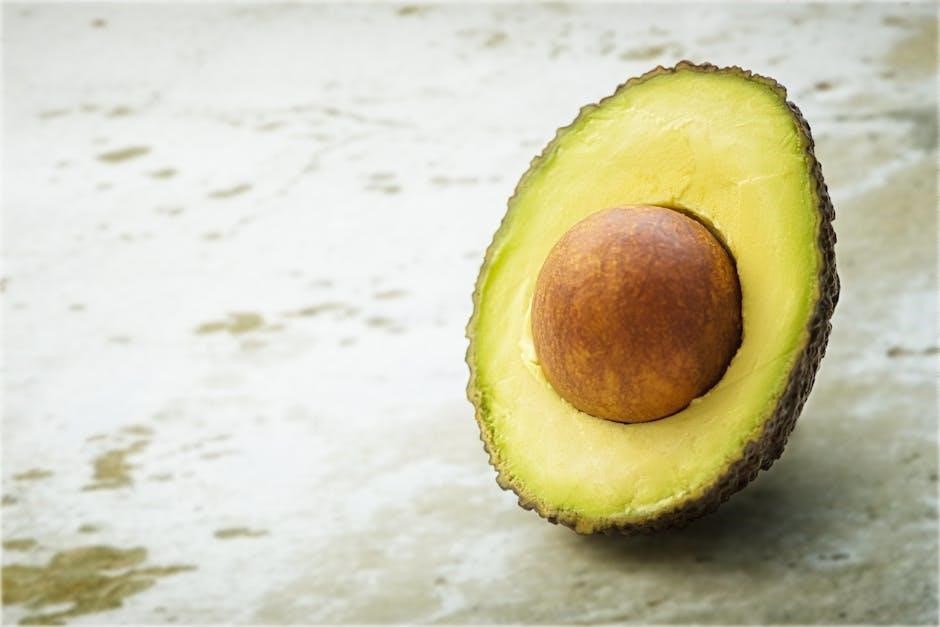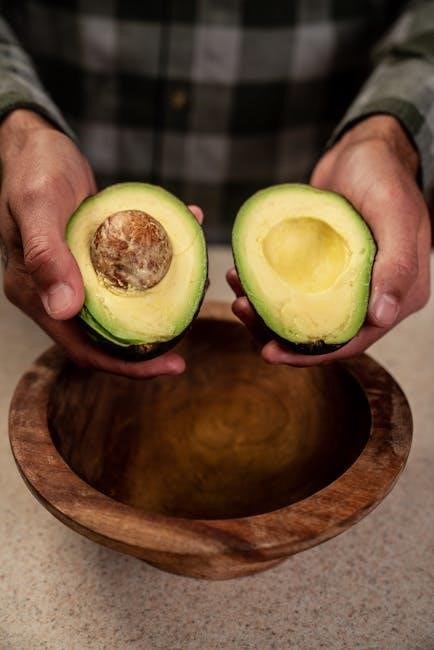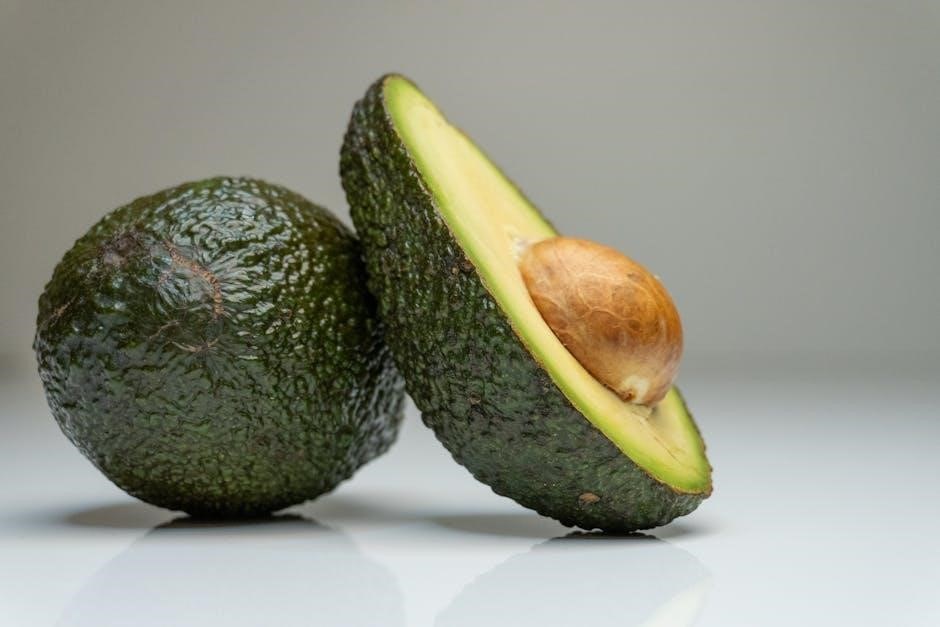A low-fat diet focuses on reducing fat intake to promote health and manage conditions like fatty liver disease. It emphasizes balanced nutrition, lean proteins, and whole grains, supporting weight loss and overall well-being.
1.1 Understanding the Basics of Low-Fat Diets
A low-fat diet limits dietary fat intake, focusing on balanced nutrition. It emphasizes whole grains, fruits, vegetables, and lean proteins, while reducing saturated and trans fats. This approach helps manage conditions like fatty liver disease and supports weight loss. By understanding food labels and portion sizes, individuals can make informed choices, ensuring a diet rich in essential nutrients while minimizing unhealthy fats.
1.2 Importance of a Low-Fat Diet for Health
A low-fat diet is crucial for maintaining overall health by reducing the risk of heart disease, obesity, and certain liver conditions. It promotes weight management, improves digestion, and lowers cholesterol levels. By focusing on nutrient-rich foods like fruits, vegetables, and whole grains, individuals can enhance their well-being while minimizing the intake of harmful fats, supporting long-term health benefits.

Food Groups in a Low-Fat Diet
A low-fat diet includes lean proteins, whole grains, fruits, and vegetables, emphasizing nutrient-rich foods that support a balanced intake while minimizing unhealthy fats and calories.

2.1 Recommended Foods: Lean Proteins and Whole Grains
Lean proteins like poultry, fish, and legumes are essential for muscle health without excess fat. Whole grains such as quinoa, brown rice, and oats provide sustained energy and fiber. These foods support a balanced diet, reducing the risk of chronic diseases while maintaining nutritional value. Incorporating them helps achieve weight management and overall well-being in a low-fat dietary plan.
2.2 Foods to Avoid: High-Fat and Processed Items
Foods high in fat, such as fried items, processed snacks, and red meats, should be minimized. Avoid saturated fats found in butter, cheese, and whole milk. Processed foods like doughnuts and pastries are also high in unhealthy fats. Limiting these items helps reduce calorie intake and lowers the risk of heart disease and weight gain, supporting a healthier low-fat dietary approach.
Sample Low-Fat Diet Food List
A sample low-fat diet includes fruits, vegetables, lean proteins, whole grains, and low-fat dairy. These foods provide essential nutrients while minimizing fat intake.
3.1 Fruits, Vegetables, and Legumes
Fresh fruits, vegetables, and legumes are ideal for a low-fat diet. Include options like apples, berries, leafy greens, and beans. Avoid adding fats like oils or creams. These foods are nutrient-rich and naturally low in fat, supporting overall health and digestion. Incorporate a variety of colors to maximize vitamin and mineral intake. Herbs and spices can enhance flavor without adding fat.
3.2 Low-Fat Dairy and Egg Options
Low-fat dairy and egg options are essential for a balanced diet. Choose skim milk, evaporated skim milk, nonfat sour cream, and yogurt made with skim milk. Opt for egg whites or low-cholesterol egg substitutes. These options reduce saturated fat intake while providing essential nutrients. They support heart health and are versatile for various recipes, making them ideal for a low-fat lifestyle.
3.3 Lean Meats and Poultry
Lean meats and poultry are excellent sources of protein in a low-fat diet. Opt for skinless chicken and turkey, lean beef cuts like sirloin, and pork tenderloin. Fish such as cod and salmon are also great choices. Always trim visible fat from meats and avoid frying. These options provide essential nutrients without excessive fat, supporting overall health and weight management effectively.
Benefits of a Low-Fat Diet
A low-fat diet supports weight loss, improves heart health, and reduces the risk of chronic diseases like diabetes and certain cancers, promoting overall well-being and longevity naturally.
4.1 Weight Management and Heart Health
A low-fat diet aids in weight management by reducing calorie intake and curbing hunger, while also lowering cholesterol and blood pressure, reducing heart disease risk. It promotes a balanced intake of nutrients, supporting sustainable weight loss and improving overall cardiovascular health. By focusing on lean proteins, whole grains, and fresh produce, this diet helps maintain a healthy weight and strengthens heart function effectively.
4.2 Improved Digestion and Reduced Disease Risk
A low-fat diet enhances digestion by reducing inflammation and improving nutrient absorption. It lowers the risk of chronic diseases like heart disease, diabetes, and liver conditions; High-fiber foods promote regular bowel movements, while avoiding processed fats reduces digestive strain. This dietary approach supports overall gut health, minimizing symptoms of irritable bowel syndrome and other digestive disorders, leading to a reduced risk of long-term health complications.

Grocery Shopping Guide
Focus on selecting low-fat options, reading nutrition labels, and avoiding processed foods. Use a shopping list to ensure you purchase healthy, nutrient-rich items efficiently.
5;1 Tips for Selecting Low-Fat Foods
- Opt for lean proteins like skinless poultry and fish, avoiding processed meats.
- Choose low-fat or fat-free dairy products, such as skim milk and yogurt.
- Select whole grains and legumes for fiber and nutrients without excess fat.
- Read labels to identify hidden fats in processed foods like snacks and sauces.
- Limit oils and use herbs or spices for flavor instead of butter or cream.
- Plan meals and create a shopping list to avoid impulse purchases of high-fat items.
5.2 Reading Nutrition Labels Effectively
When selecting low-fat foods, check the Nutrition Facts table to compare sodium and saturated fat content. Look for hidden fats in processed items and opt for products with less than 10 grams of fat per serving. Be mindful of portion sizes, as labels often apply to smaller servings than consumed. Choose foods high in nutrients but low in fat, and avoid products listing fat-rich ingredients like cheese or cream.

Meal Planning and Preparation
Plan meals ahead to ensure balanced, low-fat dishes. Use cooking methods like grilling or baking, and season with herbs instead of fats. Download a PDF guide for ideas.
6.1 Creating Balanced Low-Fat Meals
Balance meals with fresh fruits, vegetables, legumes, whole grains, lean proteins, and low-fat dairy. Incorporate herbs and spices for flavor instead of fats. Include a variety of colors to ensure diverse nutrients. Pair proteins with fiber-rich sides for satiety. Use printable guides to plan nutritious, delicious meals that align with your dietary goals, ensuring each dish is both satisfying and healthy.
6.2 Healthy Cooking Methods
Healthy cooking involves techniques like grilling, baking, poaching, and steaming, which minimize added fats. Use herbs, spices, or lemon juice for flavor. Avoid frying and opt for non-stick pans to reduce oil use. These methods retain nutrients and enhance natural flavors, making meals both nutritious and delicious while adhering to a low-fat diet.

Common Mistakes to Avoid
Overconsumption of hidden fats in processed foods and neglecting nutrient-rich options are common errors. Always check labels and avoid excessive oil use during cooking to stay on track.
7.1 Overconsumption of Hidden Fats
Hidden fats in processed foods, fried items, and sauces can derail a low-fat diet. Always check nutrition labels for fat content and avoid fried foods like fries and chips. Trim visible fat from meats and opt for low-fat cooking methods to minimize intake. Overconsumption can hinder weight loss and health goals, so mindful eating is essential.
7.2 Neglecting Nutrient-Rich Foods
Neglecting nutrient-rich foods is a common mistake on a low-fat diet. Whole grains, lean proteins, and healthy fats are essential for balanced nutrition. Ignoring these can lead to deficiencies and unsatisfying meals, potentially causing overeating. Always include a variety of fruits, vegetables, and whole grains to ensure you meet your nutritional needs while maintaining a low-fat intake. Proper meal planning can help prevent this oversight.
Resources for Low-Fat Diet Planning
Access printable PDF guides, food lists, and charts to help plan meals. Utilize online tools for tracking fat intake and managing dietary preferences effectively.
8.1 Printable PDF Guides and Charts
Downloadable PDF guides provide structured lists of low-fat foods, ideal for meal planning. Charts highlight portion sizes and fat content, aiding in grocery shopping and meal preparation. These resources often include templates for tracking daily fat intake and offer visual aids to differentiate between recommended and high-fat foods. They serve as handy tools for maintaining a balanced low-fat diet and ensuring nutritional goals are met efficiently.
8.2 Online Tools for Tracking Fat Intake
Online tools and apps simplify monitoring fat consumption, offering databases of foods with detailed nutritional information. Features like barcode scanners and meal trackers help users log intake efficiently. These tools often provide personalized recommendations and progress reports, ensuring adherence to low-fat dietary goals. They are invaluable for individuals aiming to manage their fat intake effectively and maintain a balanced diet with ease and accuracy.
Adopting a low-fat diet promotes long-term health benefits, supported by balanced meals and mindful tracking tools, helping individuals transition to a healthier lifestyle with ease and effectiveness.
9.1 Summary of Key Points
A low-fat diet focuses on reducing fat intake to improve health and manage conditions like fatty liver disease. It emphasizes lean proteins, whole grains, and fresh produce, while avoiding processed and high-fat foods. The diet supports weight management, heart health, and digestion. Printable guides and online tools provide practical resources for meal planning and tracking fat intake, making it easier to adopt and maintain a low-fat lifestyle effectively.
9.2 Encouragement for Adopting a Low-Fat Lifestyle

Embracing a low-fat lifestyle is a proactive step toward better health and well-being. By focusing on nutrient-rich foods like fruits, vegetables, and lean proteins, you can achieve weight management, improve heart health, and reduce disease risks. With practical guides and tools available, adopting this diet is both accessible and rewarding. Start your journey today and enjoy the long-term benefits of a balanced, low-fat lifestyle!



